What does the Earth look like from space?
April 22 is the International Earth Day - an annual event during which it is customary to draw attention to the protection of the environment. Let’s take a look at our planet from different parts of the Solar System and see how fragile and small our world is: the first picture from this list is the flag of this holiday and was taken by the only scientist who visited the Moon - Harrison Schmitt , on December 7, 1972, when he sent Apollo- 17 ”from the earth’s orbit. He even got his own name: "Blue Marble . "
The first photograph of the Earth from space (altitude 105 km) taken from the V-2 rocket. October 24, 1946 in New Mexico, USA.
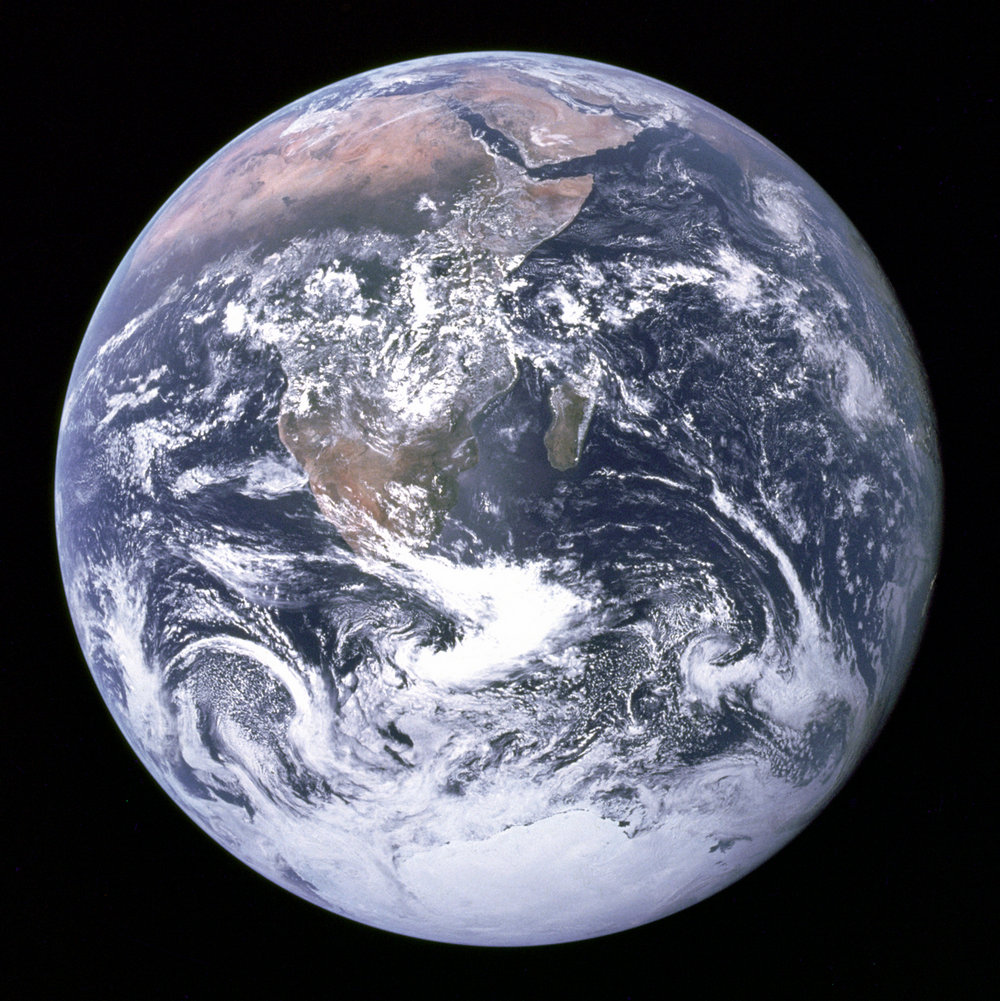
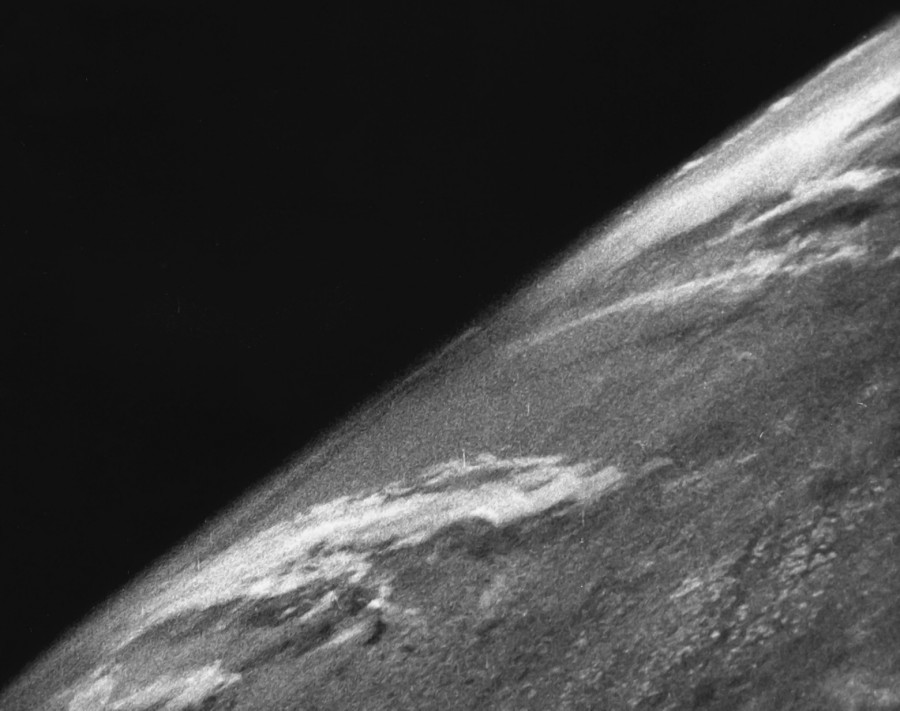
Yuri Gagarin did not shoot in his historical flight, but only described what he saw and broadcast on the radio. Therefore, the title of the first "space photographer" went to the astronaut Alan Shepard , who made the first suborbital flight for the United States on May 5, 1961 from Cape Canaveral. On August 6, 1961,
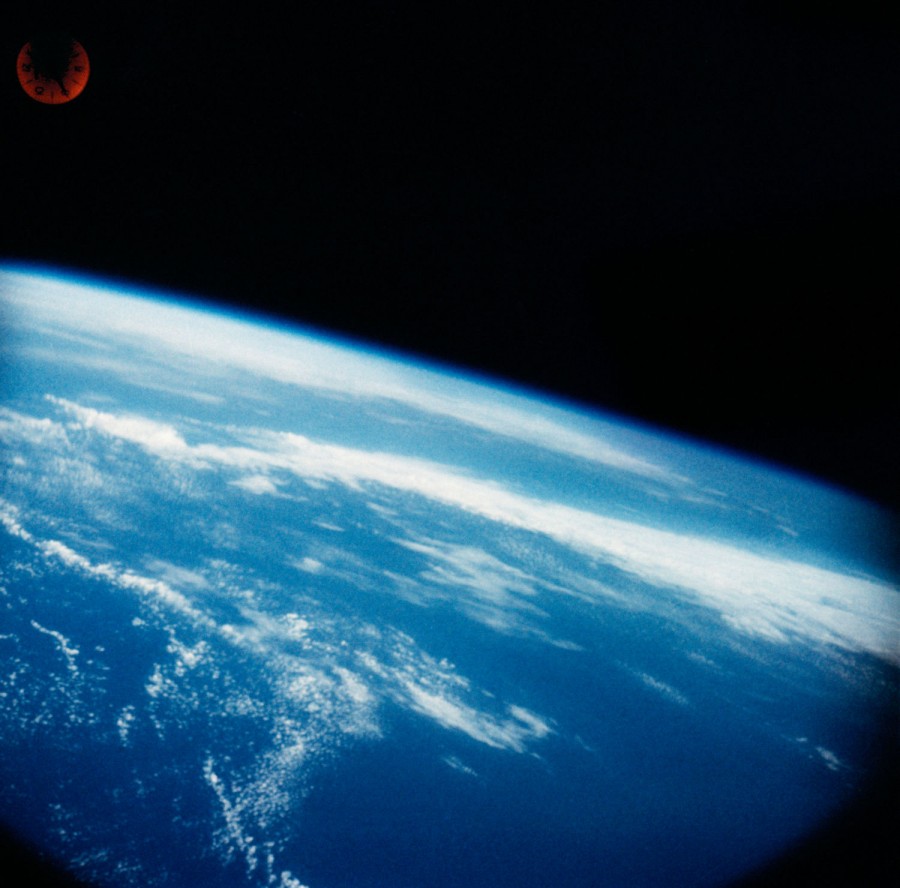
German Titov not only became the second person in Earth orbit, but also the second space photographer. He also still holds the title of the youngest man to space: at the time of the flight he was 25 years old and 11 months old.
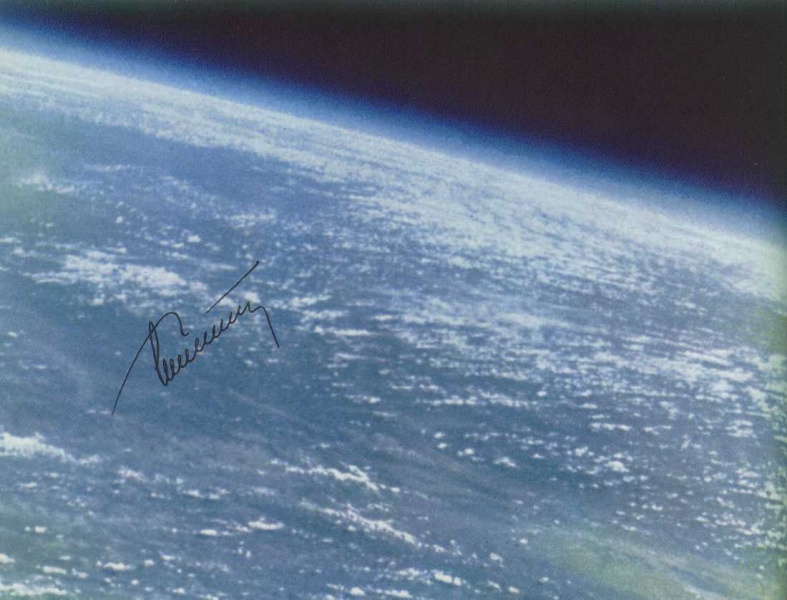
The first color image of the entire Earth was obtained in August 1967 by the DODGE satellite . In 2012 and 2016 using the Suomi NPP weather satellite
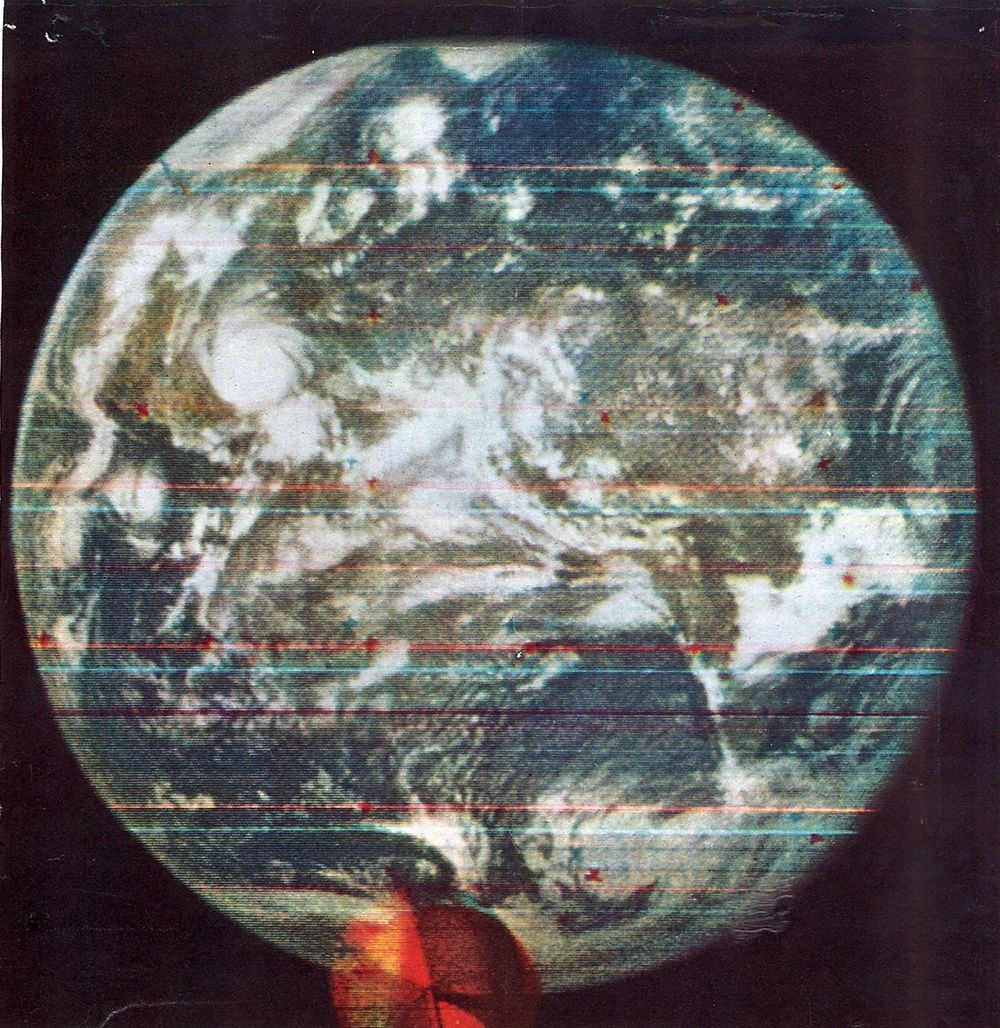
night pictures were taken of the earth’s surface from which then NASA composed a mosaic called “Black Marble”. The pictures clearly show how the night illumination of India has grown over 4 years. Also, many beautiful pictures of the Earth are taken by people from the ISS. Here's an example of a moonrise, Venus and the Sun above the Aurora taken in May 2017 by astronaut Thomas Peske :
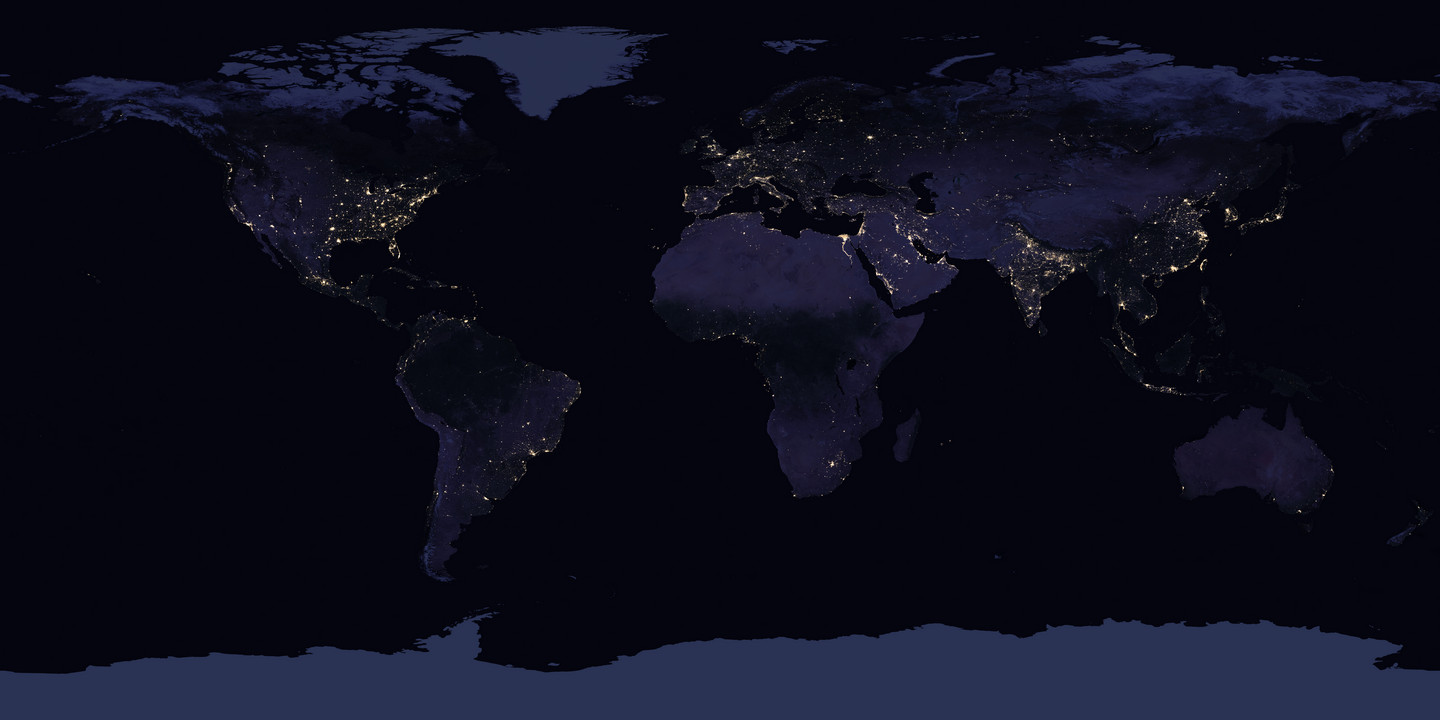
In addition to the Blue Marble, astronauts flying to the Moon received another famous picture - this is Earth Rise, made on December 24, 1968 by William Anders of the Apollo 8 crew, the first to fly around the Moon. On April 5, 2008, the Kaguya moon satellite of the Japanese space agency JAXA recorded a video of the same nature on a camera with a CCD of only 2.2 megapixels.
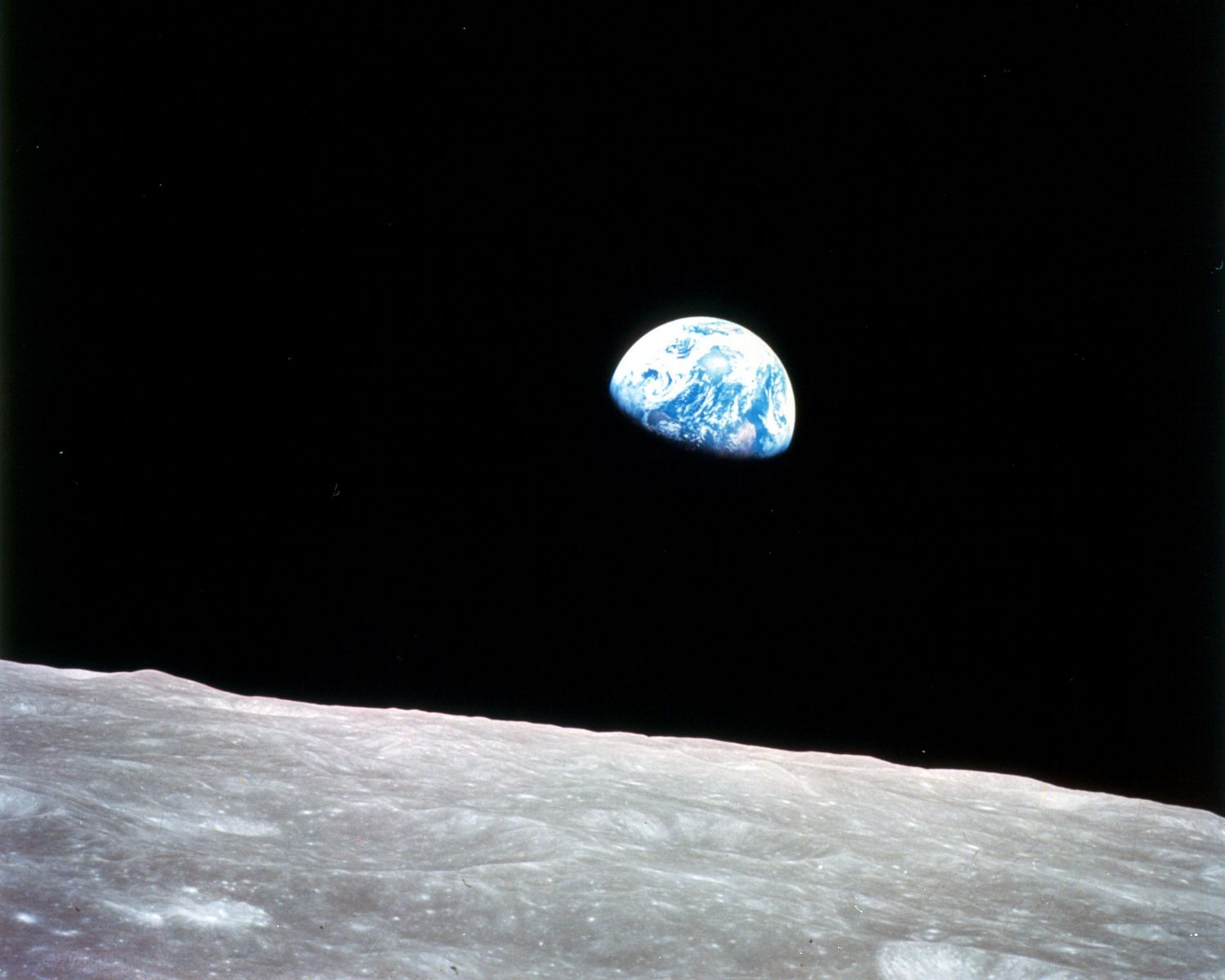
On May 21, 2018, together with the Chinese repeater satellite Chang'e-4, two small Longjiang-1 and -2 small vehicles weighing 45 kg each went to the Moon. Communication with the first of them was lost and their mission for radio interferometry with an extra-long base had to be canceled. However, Longjiang-2 remained a worker and was able to transfer this and several other images of the Earth from the lunar orbit taken to a camera made in Saudi Arabia.
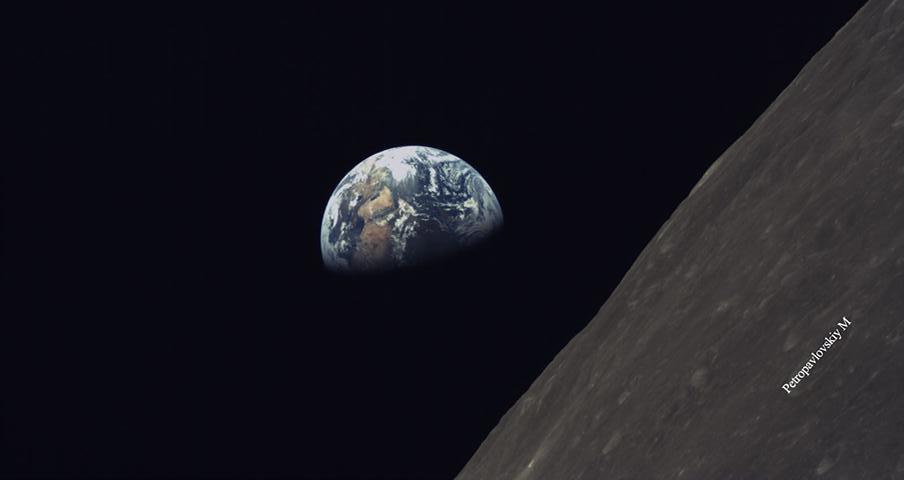
On July 5, 2016, the DSCOVR satellite located at the Lagrange point L1 (1.5 million km from the Earth towards the Sun) recorded the passage of the Moon through the Earth's disk.
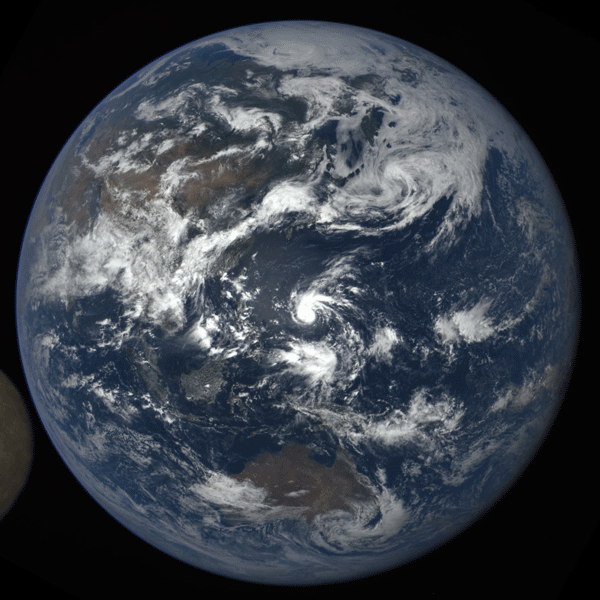
A combined image of the Earth and the Moon taken on October 2, 2017 from a distance of 5 million km with the MapCam camera of the OSIRIS-REx probeintended for the delivery of soil from the asteroid Bennu. On September 18, 1977, Voyager 1 took the first joint image of the Earth and the Moon from a distance of 11.66 million km during the inspection of its cameras. This is again OSIRIS-REx, but already on January 17, 2018, the NavCam1 camera and a distance of 63.6 million km. On May 6, 2010, the MESSENGER probe took a picture of the Earth and the Moon from the orbit of Mercury (distance 183 million km) on which our planet and its natural satellite look just like two bright stars. The resolution of the HiRISE MRO camera in the Martian orbit (distance of 142 million km) is much higher, but even on it the Earth and the Moon look like small balls with a diameter of 90 and 24 pixels, respectively. The picture was taken on October 3, 2007.

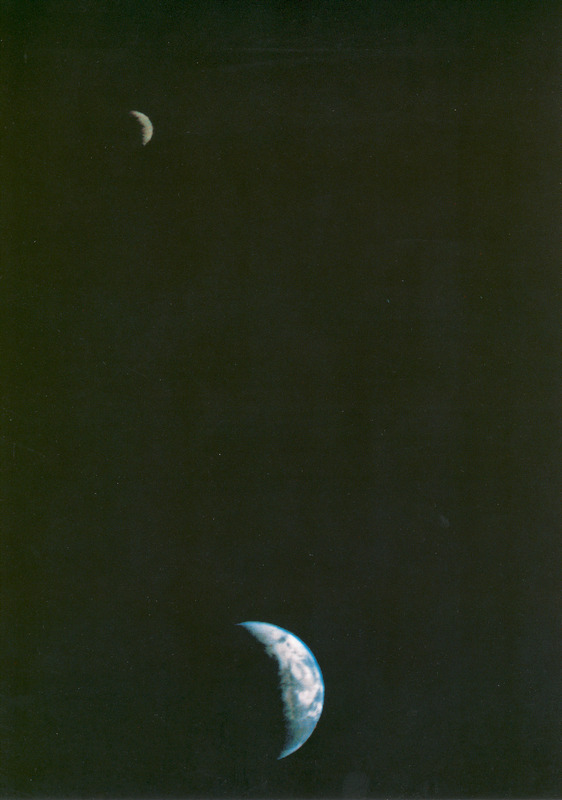

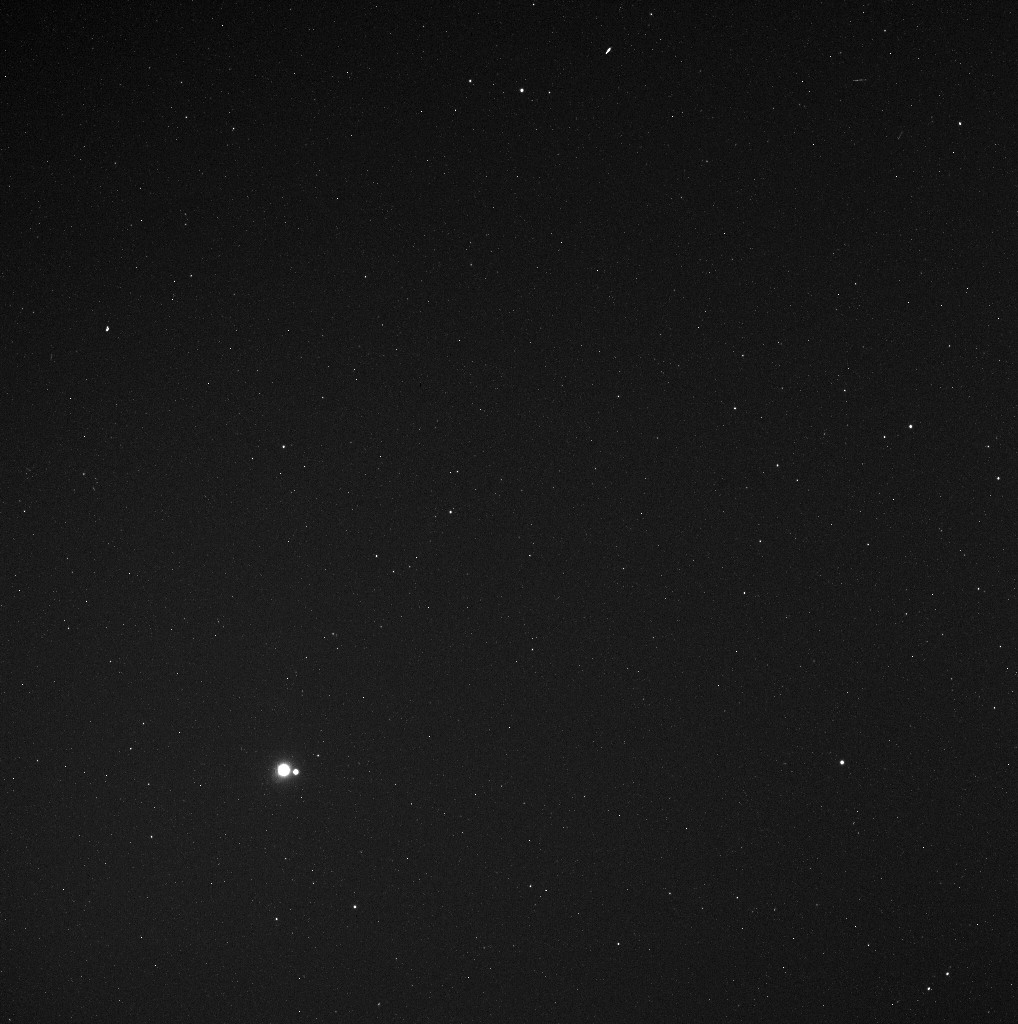

On December 10, 2017, the Earth accidentally fell into the frame of the Kepler telescope looking for an exoplanet, and thereby illuminated the image, despite the distance of 150 million km.
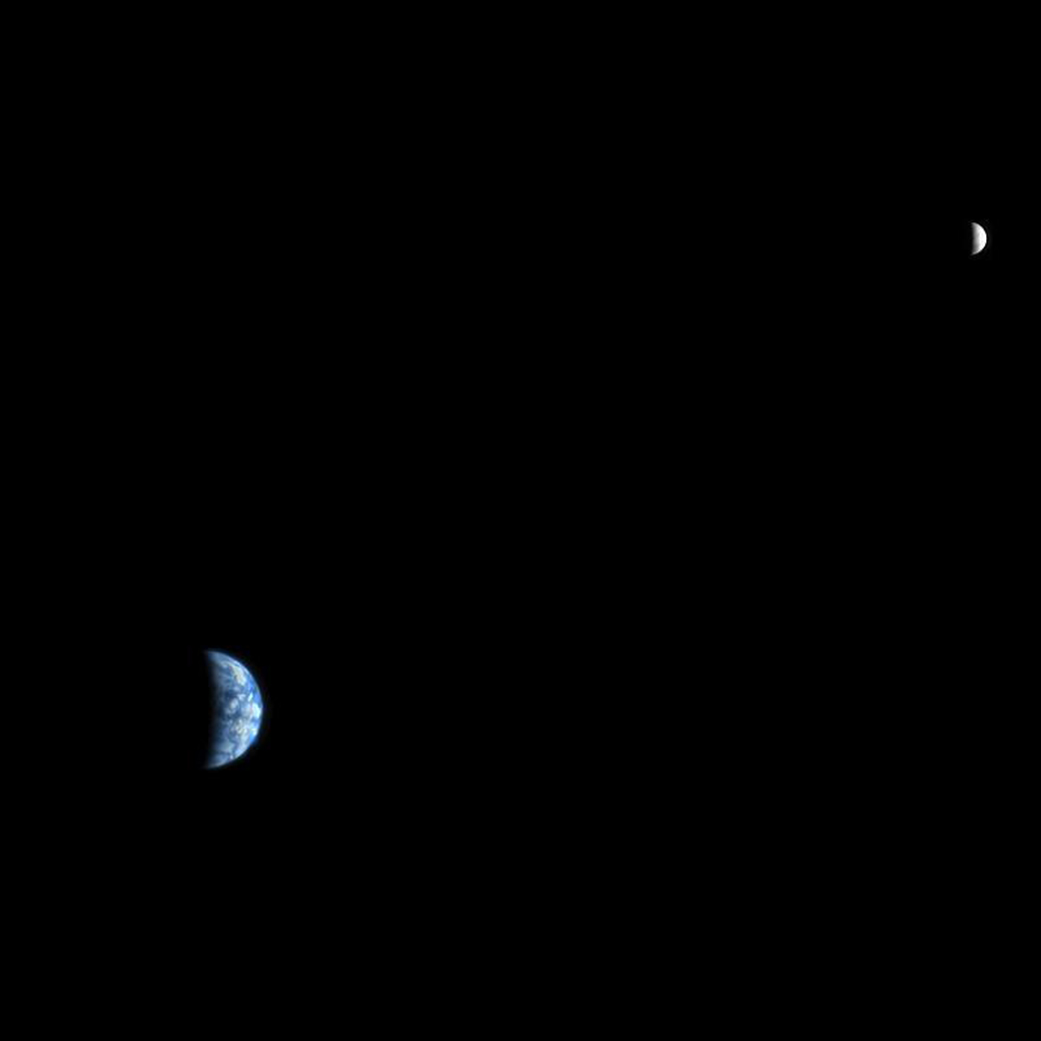
Already from the surface of Mars, the Curiosity rover, the Earth and the Moon are visible as two small points - this image was taken on January 31, 2014 from a distance of about 160 million km. On December 16, 1992, a Galileo probe made a common image of the Earth and the Moon in the violet, red, and near-infrared ranges when it flew away to Jupiter (distance of 6.2 million km). On July 19, 2013, the Cassini probe took 323 images of a picture of the Saturn system, based on 141 of which a mosaic was made on which apart from Saturn itself and its satellites a small point is visible - our Earth.

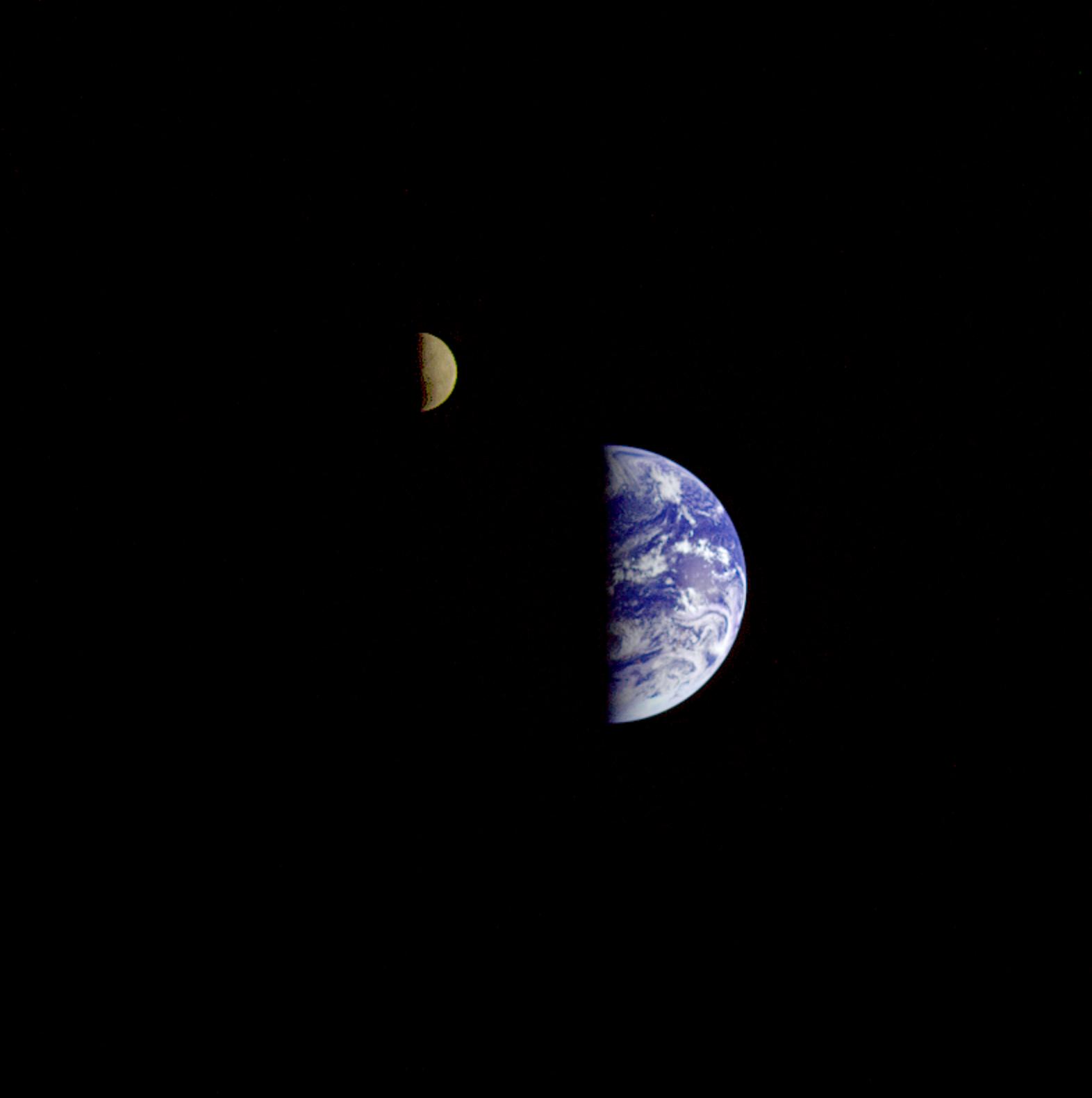
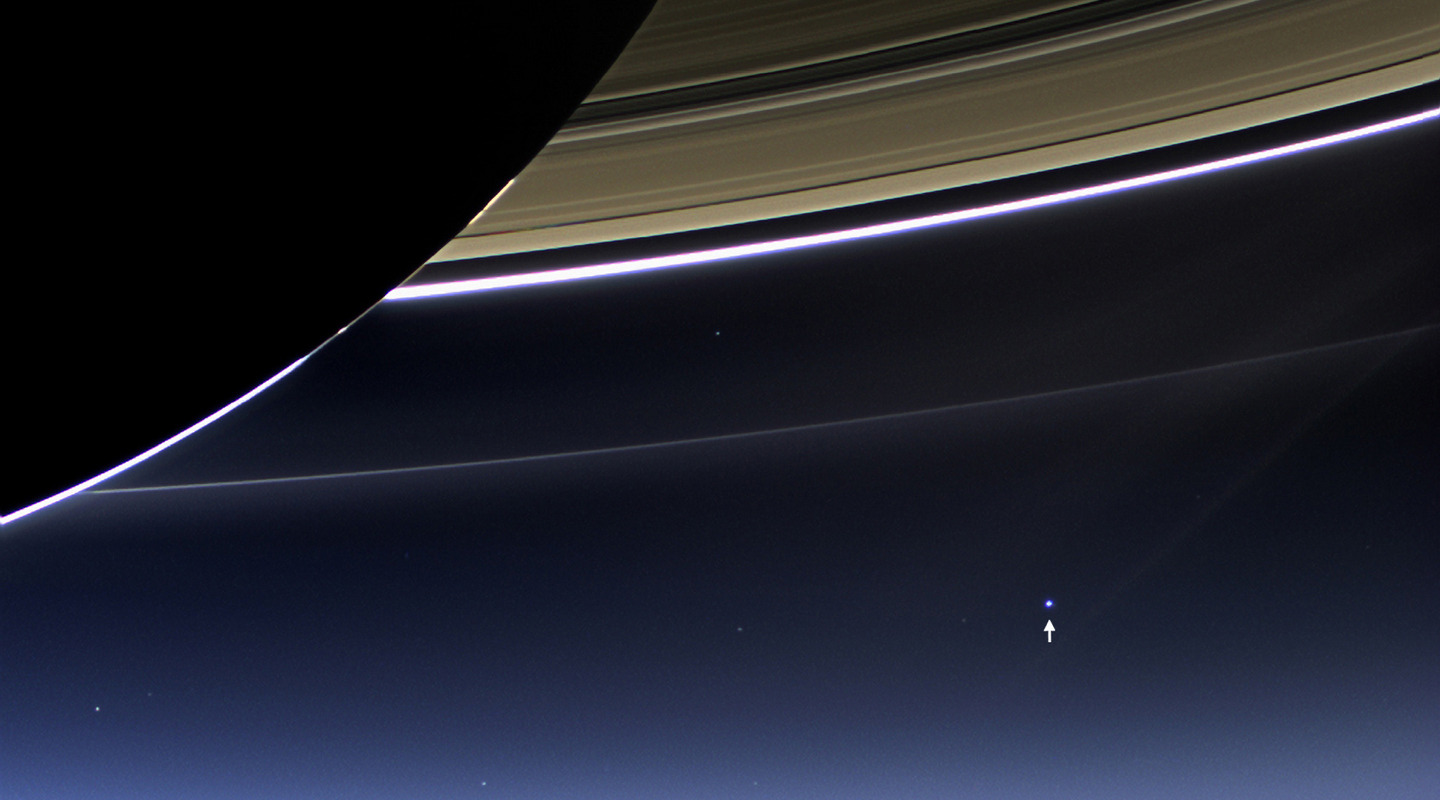
Along with this image, NASA organized the “Swing Saturn” campaign, during which 1600 volunteer images were taken, from which the collage “Day When the Earth Smiled” similar to the general image was taken : And finally, the farthest image of the Earth - “Pale Blue Point” made February 14, 1990, Voyager 1 from a distance of 6.4 billion km (that distance corresponds to the orbit of Pluto recently demoted from planets). The angular resolution of the narrow-angle cameras of the Voyagers from such a distance was 9 Earth diameters per pixel. The moon in the photo is also there, but it is already completely indistinguishable - even the Earth on it is hardly visible on the background of the glare of the Sun. As Carl Sagan put it
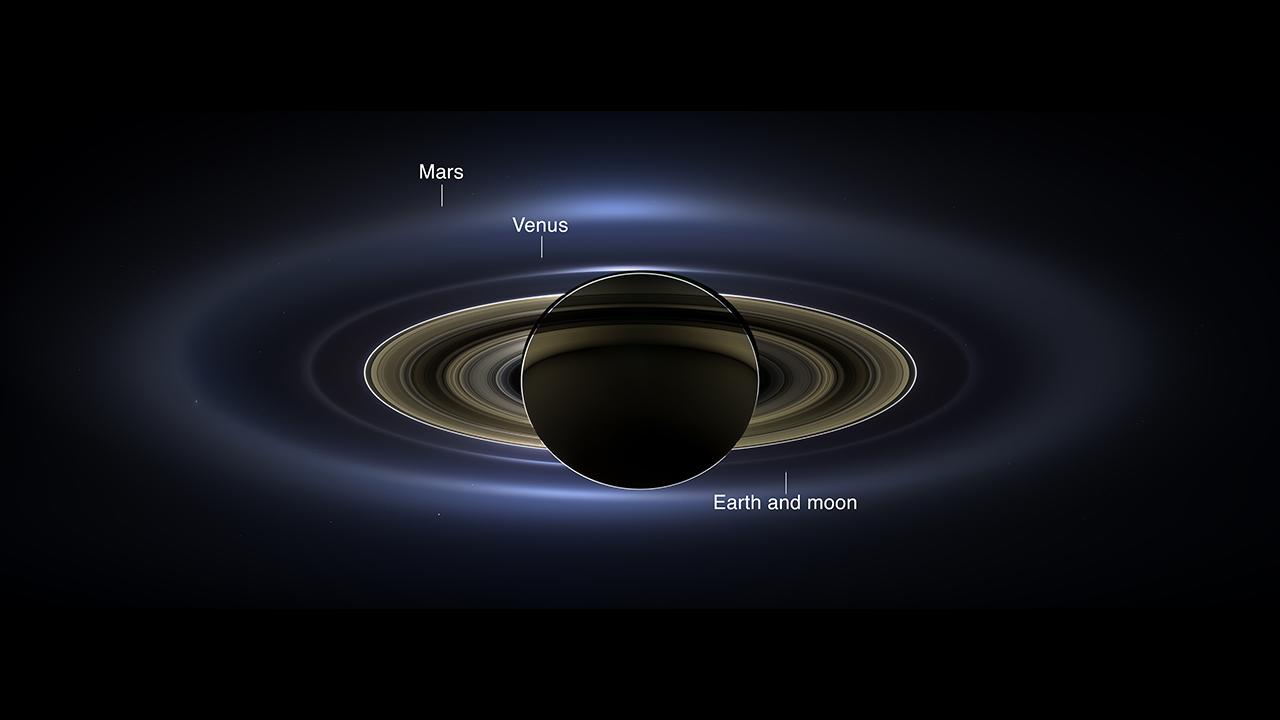

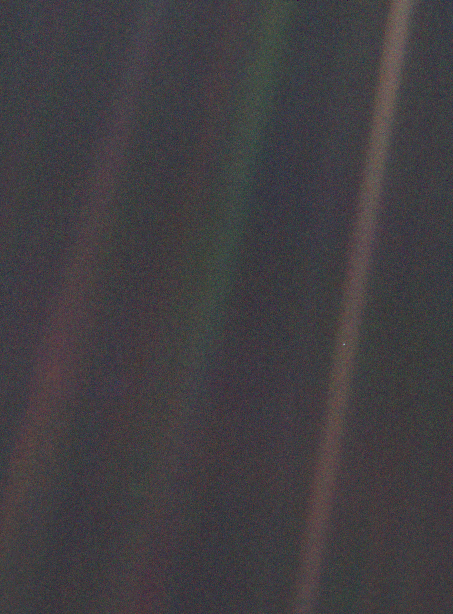
thanks to which this photo was born:
Some indicate that astronautics divert our attention and money from Earth's problems, but how the famous astrophysicist Neil Degrass Tyson does not cease to repeat :
It is with the advent of astronautics and flights to the moon that the appearance of: International Earth Day, the banning of tetraethyl lead as fuel additives and the introduction of catalytic converters, the emergence of the US Environmental Protection Agency and acts to protect water and air , as well as the growing interest in studying changes climate - to the cosmonautics that showed us the insignificance of the size of the Earth on a space scale, in fact, we owe such an interest in it.


Yuri Gagarin did not shoot in his historical flight, but only described what he saw and broadcast on the radio. Therefore, the title of the first "space photographer" went to the astronaut Alan Shepard , who made the first suborbital flight for the United States on May 5, 1961 from Cape Canaveral. On August 6, 1961,

German Titov not only became the second person in Earth orbit, but also the second space photographer. He also still holds the title of the youngest man to space: at the time of the flight he was 25 years old and 11 months old.

The first color image of the entire Earth was obtained in August 1967 by the DODGE satellite . In 2012 and 2016 using the Suomi NPP weather satellite

night pictures were taken of the earth’s surface from which then NASA composed a mosaic called “Black Marble”. The pictures clearly show how the night illumination of India has grown over 4 years. Also, many beautiful pictures of the Earth are taken by people from the ISS. Here's an example of a moonrise, Venus and the Sun above the Aurora taken in May 2017 by astronaut Thomas Peske :

In addition to the Blue Marble, astronauts flying to the Moon received another famous picture - this is Earth Rise, made on December 24, 1968 by William Anders of the Apollo 8 crew, the first to fly around the Moon. On April 5, 2008, the Kaguya moon satellite of the Japanese space agency JAXA recorded a video of the same nature on a camera with a CCD of only 2.2 megapixels.

On May 21, 2018, together with the Chinese repeater satellite Chang'e-4, two small Longjiang-1 and -2 small vehicles weighing 45 kg each went to the Moon. Communication with the first of them was lost and their mission for radio interferometry with an extra-long base had to be canceled. However, Longjiang-2 remained a worker and was able to transfer this and several other images of the Earth from the lunar orbit taken to a camera made in Saudi Arabia.

On July 5, 2016, the DSCOVR satellite located at the Lagrange point L1 (1.5 million km from the Earth towards the Sun) recorded the passage of the Moon through the Earth's disk.

A combined image of the Earth and the Moon taken on October 2, 2017 from a distance of 5 million km with the MapCam camera of the OSIRIS-REx probeintended for the delivery of soil from the asteroid Bennu. On September 18, 1977, Voyager 1 took the first joint image of the Earth and the Moon from a distance of 11.66 million km during the inspection of its cameras. This is again OSIRIS-REx, but already on January 17, 2018, the NavCam1 camera and a distance of 63.6 million km. On May 6, 2010, the MESSENGER probe took a picture of the Earth and the Moon from the orbit of Mercury (distance 183 million km) on which our planet and its natural satellite look just like two bright stars. The resolution of the HiRISE MRO camera in the Martian orbit (distance of 142 million km) is much higher, but even on it the Earth and the Moon look like small balls with a diameter of 90 and 24 pixels, respectively. The picture was taken on October 3, 2007.





On December 10, 2017, the Earth accidentally fell into the frame of the Kepler telescope looking for an exoplanet, and thereby illuminated the image, despite the distance of 150 million km.

Already from the surface of Mars, the Curiosity rover, the Earth and the Moon are visible as two small points - this image was taken on January 31, 2014 from a distance of about 160 million km. On December 16, 1992, a Galileo probe made a common image of the Earth and the Moon in the violet, red, and near-infrared ranges when it flew away to Jupiter (distance of 6.2 million km). On July 19, 2013, the Cassini probe took 323 images of a picture of the Saturn system, based on 141 of which a mosaic was made on which apart from Saturn itself and its satellites a small point is visible - our Earth.



Along with this image, NASA organized the “Swing Saturn” campaign, during which 1600 volunteer images were taken, from which the collage “Day When the Earth Smiled” similar to the general image was taken : And finally, the farthest image of the Earth - “Pale Blue Point” made February 14, 1990, Voyager 1 from a distance of 6.4 billion km (that distance corresponds to the orbit of Pluto recently demoted from planets). The angular resolution of the narrow-angle cameras of the Voyagers from such a distance was 9 Earth diameters per pixel. The moon in the photo is also there, but it is already completely indistinguishable - even the Earth on it is hardly visible on the background of the glare of the Sun. As Carl Sagan put it



thanks to which this photo was born:
Our planet is just a lone speck of dust in the surrounding cosmic darkness. In this grandiose void, there is not a hint that someone will come to our aid in order to save us from ourselves.
It seems to me that she emphasizes our responsibility, our duty to be kinder to each other, to preserve and cherish the pale blue dot - our only home.
Some indicate that astronautics divert our attention and money from Earth's problems, but how the famous astrophysicist Neil Degrass Tyson does not cease to repeat :
Only when we went to the Moon to study it, we looked back and for the first time discovered the Earth for ourselves.
It is with the advent of astronautics and flights to the moon that the appearance of: International Earth Day, the banning of tetraethyl lead as fuel additives and the introduction of catalytic converters, the emergence of the US Environmental Protection Agency and acts to protect water and air , as well as the growing interest in studying changes climate - to the cosmonautics that showed us the insignificance of the size of the Earth on a space scale, in fact, we owe such an interest in it.
